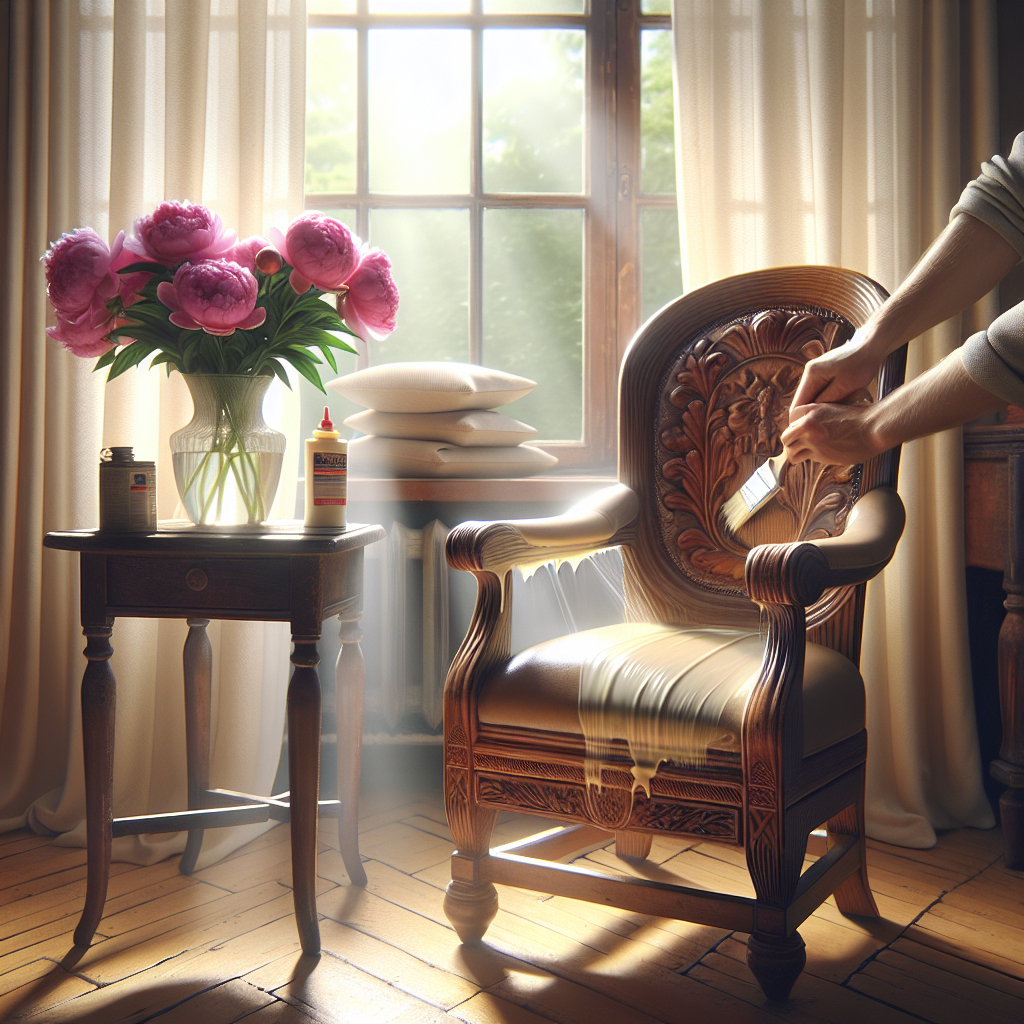Protecting and Caring for Painted Furniture
Protecting and Caring for Painted Furniture


Welcome to the blog, lovers of painted furniture! One cannot deny painted furniture's allure to our home's ambiance. That old wooden chair gets a new lease on life with a vibrant coat of paint. Even a newly bought, hand-painted antique dresser draws attention as it elegantly contrasts the decor of your room. But as the saying goes, "With great beauty, comes great responsibility," and your painted furniture is no exception. This article aims to be your comprehensive guide for protecting and caring for your painted furniture with extra care, ensuring its aesthetic appeal remains undiminished for years to come.
Importance of protecting and caring for painted furniture
Caring for your painted furniture is more than a routine; it's a commitment that could significantly extend your favourite piece of furniture's lifespan. Just imagine your favourite chairs, dressers, or tables looking beautiful for many more years. Ensuring the longevity of your painted furniture not only preserves its beauty but also retains its value. It is about preventing unnecessary wear, avoiding material damage, and maintaining its overall vibrant appearance. In short, it's about guaranteeing that you continue to enjoy your painted piece of furniture as a splendid part of your home decor.
Choosing the Right Paint and Sealant
Now that we're well-versed in the importance of furniture care, let's delve into how to choose the right paint and sealant for the perfect colour and styling. Observing due diligence in this initial stage is essential to achieving a durable, beautiful painted finish that endures daily use without the colour fading away. Remember, investing in the quality of these products isn't just about the health of your furniture but ensuring value for expense.
Types of paint suited for furniture
When it comes to suitable paints for your furniture, the market is flooded with options. However, putting in a little extra thought at this stage can ensure the success of your endeavour. Here are some commonly recommended types of paint for your furniture.
● Acrylic Paint: For a wide palette of colours and fast-drying properties.
● Chalk Paint: Best for rustic, matte looks without needing a primer.
● Milk Paint: Recognised for its environmentally friendly composition.
● Latex Paint: Quite durable, ideal for furniture receiving regular usage.
● Oil-Based Paint: Extremely durable and known for a rich, glossy finish; perfect for high-impact pieces.
Pros and cons of different sealants
Just like paint selection, choosing the right sealant for your furniture depends on the desired finish and function of your piece. Here's a side-by-side comparison of three commonly used sealants:
Wax:
Pros: Easy to apply, natural finish
Cons: Requires regular reapplication, not heat resistant
Shellac:
Pros: Natural and non-toxic, glossy finish
Cons: Not waterproof, can turn white with water contact
Varnish:
Pros: Highly durable, waterproof
Cons: Complex application process, requires good skill
Cleaning and Maintenance of Painted Furniture
Proper cleaning and maintenance are the keys to extending your furniture's life. Regular cleaning prevents the build-up of dust and debris that can scratch or stain the painted surface over time. Treating stains, scuffs, and scratches promptly with specialised stain removers can keep your piece looking its best. Remember, it's not just about reactive measures; taking proactive steps will save your time and effort in the long run and give your furniture a new lease of life.
How to clean and dust painted surfaces
For routine cleaning, gently rubbed across painted surfaces, a soft, lint-free cloth can effectively remove dust and dirt. If a deeper clean is needed, dampen the cloth with a mild soap solution, wipe the surfaces and dry completely using a dry cloth. Be careful not to oversoak the cloth as this might leave water streaks on your furniture. Also, beware of using traditional household cleaners that contain alcohol or other harsh chemicals that can harm the paint. Instead, use a small amount of gentle dishwashing detergent or clear wax to remove stubborn dirt or stains. Always test any new cleaner in an inconspicuous spot to ensure it won't damage your piece.
Tips for stain removal
Accidents happen, and sometimes they can leave unwanted stains. Here are some prompt and crafted recommendations for when such incidents occur:
● Address spills immediately! Time is of the essence to prevent staining.
● Use a clean, damp cloth to blot the spill; avoid rubbing.
● For stubborn stains, mild dish soap mixed with water can be helpful.
● Never use abrasive materials or harsh chemicals which might damage the paint.
● In case of severe stains, consider professional repair or repainting the affected area.
Dealing with scratches and scuffs
We all dread finding that first scratch or scuff on our beloved painted furniture. However, don't despair! Small tears, scratches, or scuffs can often be handled at home with a touch-up pen matching the paint colour. For more significant scratches, gently sand the area and apply a new coat of paint. When repainting isn't an option, consider professional restoration services, such as leather restoration for furniture specialists. But prevention is always better than cure, so remember to handle the furniture with care and avoid placing sharp objects directly on its surface.
Caring for Oak Furniture
Oak furniture, with its unmistakable grain patterns, is well-loved in many households. Unfortunately, the natural oils and tannins in oak that give it such character can react with certain paints, causing discolouration. Therefore, special care advice applies to this stylish subset of painted furniture. Let's explore how to make your oak pieces last a lifetime without compromising their touch of class and sophistication, using natural alternatives like tung oil for wood care.
Cleaning and polishing oak furniture
Routine dusting will keep your oak looking fresh. For deeper cleaning, a slightly damp soft cloth can be used, followed by immediate drying. Furnishing formulas such as beeswax polish are recommended for use on oak due to their adherence to the wood's natural texture. Apply sparingly with a soft cloth, let it dry, and then buff until the wax has been absorbed, achieving that perfect shine. For fine wooden surfaces, beeswax polish is a popular and effective choice for cleaning and polishing oak furniture. It is a natural formula that feeds, enhances, and protects all types of fine wooden surfaces. Never use silicone-based polishes, as they can cause damage over time. Similarly, avoid all-purpose sprays containing ammonia or other harsh chemicals.
How to prevent damage to oak furniture
While oak is relatively robust, it still demands certain care measures. Here are our best tips:
● Do not place oak furniture near heat sources like heaters or radiators.
● Avoid exposure to high moisture levels, which can lead to warping.
● Regularly rotate any decorative items on oak surfaces to prevent discolouration and impressions.
● Use tablecloths, coasters, and trivets to safeguard against potential stains and heat damage.
● Treat any spills immediately to prevent staining.
Avoiding Common Mistakes
Despite our best efforts, it's all too easy to harm our furniture unintentionally. Overpolishing, exposure to extreme temperatures, direct sunlight, or using the wrong cleaning products can gradually degrade your painted furniture. Also, temptation may lead us to place a hot cup of coffee directly on a painted table or keep a piece too close to the fireplace. Being mindful of these common pitfalls and taking precautions can enhance your furniture's longevity and appearance. Remember to always use a coaster for hot drinks and never use hot tools on the surface of your furniture piece.
Do not expose to extreme temperatures or humidity
Both intense temperatures and humidity levels can wreak havoc on your painted furniture. High heat can cause the paint to peel and crack, while excessive humidity can lead to swelling and warping of the wood. Avoid placing your furniture near radiators, AC vents, or open windows. Additionally, do not place any hot items directly onto the surface of your painted furniture, as this can also cause damage. Maintaining your home's temperature and humidity levels is not just good for your health; it helps protect your furniture, too!
Be mindful of decor placement
While it's tempting to adorn your polished dresser or luxury oak bed with ornaments and accessories, remember they can mark the furniture over time. Always use felt backing for heavy items and rotate their positions regularly. Furthermore, think twice before using candles and diffusers; essential oils can harm painted surfaces. Essentially, approach the placement of your decor with care and consideration, and always use protective solutions.
Safely Moving and Rearranging Furniture
Whether it's house shifting or just routine rearranging, moving furniture is inevitable. However, incorrect handling during these times can lead to scratches, dents, and other unwanted damage. Learn how to safeguard your painted surfaces while moving and the proper techniques for lifting your furniture to avoid potential harm.
Protecting painted surfaces while moving
Before moving, secure your furniture by removing any loose or removable parts and using bubble wrap or moving blankets for protection. Never drag furniture across the floor; lifting it is safer for both furniture and flooring. Use felt pads underneath objects that will rest on top of your furniture, like lamps or vases, to help prevent scratches. Most importantly, always ask for help when moving larger pieces!
Proper techniques for lifting and carrying
When it comes to lifting and carrying furniture, pay attention to object weight and your limitations. If a piece is too heavy, don't hesitate to seek help. Always lift by bending your knees and keeping the load close to your body. Avoid twisting while carrying furniture, and take care not to bump the piece against walls or doorways. In essence, respect your limitations, prioritise safety, and proceed with the utmost discretion when handling your furniture.
